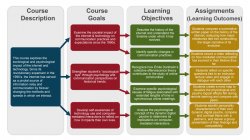Utilizing a design framework throughout the development of your course provides benefits for both students and faculty. Course design frameworks establish consistency in design while providing a model to follow throughout development and while teaching, enabling the integration of pedagogical best practices throughout each element of your course. In short, course design frameworks make your course the best it can be, enhance the student experience, and streamline the teaching experience for faculty.
Learn about a few of the frameworks and practices in use at Montclair State below and the benefits they offer you and your students.
Backwards Design: Designing With Goals in Mind
A student’s learning journey in your course concludes with their achievement of goals defined by you at the start of the semester. What concepts should be mastered, and how do we facilitate that mastery? The path to achieving those goals typically entails students’ active engagement with course materials, activities, discussions, assessments and much more.
The backwards course design model helps you facilitate your students’ learning journey by planning every aspect of your course around your course goals. The lectures you plan, the activities and assessments you design, and the way you organize your content should be inspired by (and align with) these learning goals to help students achieve them.
Wiggins and McTighe’s Understanding by Design (UbD) framework follows a “backwards” design approach. They recommend you start by defining your course goals and learning outcomes (LOs). You then determine learning assessments. What evidence is needed to confirm students met LOs? Lastly, you design learning activities. How can students develop LOs? Consider ways to structure, chunk, and present content. Regardless of the modality you teach in, all activities, content and assessments should connect back to what you want your students to know or do as a result of your course.
The diagram below illustrates an example of the alignment between course goals, learning objectives and learning outcomes for a course. Take a look at more details about this course and the assignments: The Sociology of Cyberspace

Montclair’s OCIA Course Design Model
The OCIA Course Design model supports a social, interaction-embedded approach to course design and development and uses learning modules to structure the course in Canvas. Although this is particularly helpful for online and hybrid courses, students appreciate the structure this offers when taking in person courses as well. The OCIA model establishes consistency in the way learning modules are designed and content is presented to your students. This reduces confusion and guesswork by students on where to find various resources and assignments in Canvas. Montclair State has developed and continues to improve a course template based on this approach.
For more details, please visit our OCIA Course Design Model page.
Universal Design for Learning
Universal Design for Learning (UDL) is a set of principles for curriculum development that give all individuals equal opportunities to learn. These principles are helpful to consider when designing courses.
The 3 Principles of Universal Design for Learning (UDL) are:
Learners differ in the ways they perceive and comprehend information. Three examples on how to provide multiple means of representation are the following:
- Present course material in multiple media, such as a combination of written work (articles, textbook chapters, etc.) and multimedia (video lectures, relevant YouTube content, TED Talks, etc.).
- Provide alternative text descriptions (alt text) to accompany diagrams and other images.
- Ensure all multimedia content is accurately captioned.
Learners differ in the ways they can navigate a learning environment and express what they know. Three examples on how to provide multiple means of action and expression are the following:
- Vary the means in which students demonstrate competency and achievement of learning outcomes. Do not rely solely on one assessment method.
- Enable opportunities for students to reflect on their learning experiences and receive feedback on performance and progress towards learning goals.
- Leverage instructional technologies such as Perusall, Flipgrid, VoiceThread, and other spaces where students can express competencies in varied ways while gaining experience using different technologies.
Learners differ in the ways they can be engaged or motivated to learn. Three examples of how to provide multiple means of engagement are the following:
- Consider incorporating projects where students can select one of the multiple avenues of completion (i.e. options to either deliver a presentation or compose a paper)
- Encourage students to contribute individual learning goals of their own to achieve during the semester.
- Incorporate individual, pair, small group, and large group activities.
- CAST (2018). Universal Design for Learning Guidelines version 2.2. Retrieved from http://udlguidelines.cast.org
- “Standards from the Quality Matters Higher Education Rubric, Sixth Edition. Quality Matters. Retrieved from Specific Review Standards from the QM Higher Education Rubric, Sixth Edition
- Wiggins, G. & McTighe, J. (2005). Understanding by Design. ASCD.
